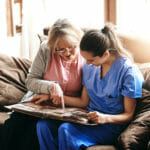America’s elderly population is expected to rise from 46 million in 2016 to approximately 70 million by 2030.
To ensure optimal health outcomes for older adults, nurses in all settings should be familiar with geriatric health problems and demonstrate proficiency in providing care. Becoming proficient in geriatric assessment, in regards to the physiologic changes unique to this population, requires both training and experience, and several models of geriatric nursing care are on the forefront of this growing health area.
What is Geriatric Nursing?
IN THIS ARTICLE
Geriatric nursing is a specialized field of nursing that focuses on the care of older adults. It involves understanding the physiological changes that occur as people age and how these changes affect communication, social interactions, and the ability to perform daily activities. Geriatric nurses work with families and other healthcare professionals to provide evidence-based care that meets the unique needs of older adults.
One of the key aspects of geriatric nursing and in-home senior care is understanding the communication needs of older adults.
As people age, they may experience hearing loss, vision problems, and cognitive decline, which can make communication more difficult. Geriatric nurses must be able to communicate effectively with older adults, using clear and simple language and taking the time to listen and respond to their concerns.
Another important aspect of geriatric nursing is the care of older adults with chronic disorders. Many older adults have multiple chronic conditions, such as diabetes, heart disease, and arthritis, which require ongoing management and treatment.
Geriatric nurses must be knowledgeable about the latest treatments and medications for these conditions and be able to provide effective care that helps older adults manage their symptoms and maintain their quality of life.
Geriatric nursing can take place in a variety of care settings, including home care, acute care, and long-term care facilities.
Geriatric nurses may work as RNs or nurse practitioners, providing clinical information and management advice to other healthcare professionals and working with staff to develop staff development programs that promote best practices in geriatric care.
To stay up-to-date on the latest developments in geriatric nursing, many nurses read peer-reviewed articles and journals that focus on geriatric care. They may also attend conferences and workshops that provide training on new treatments and techniques for caring for older adults.
While some physical attributes of aging, such as graying hair and wrinkled skin, are obvious when recognizing the initial perceptions of conditions that may be related to aging, other changes aren’t always related solely to aging; some may stem at least in part from lifestyle and environmental factors. The chief signs a Geriatric Nurse reviews during an initial patient consult include the following:
Assessing the skin
In addition to the issues that wrinkled skin results from loss of elasticity and turgor, the skin on a geriatric patient gradually thins and loses density, making it more susceptible to bruising and tears. Other conditions that the Geriatric Nurse will examine for on an elderly patient include both pressure sores and moles.
Assessing the nails
Nail surfaces normally are flat or slightly curved on all individuals regardless of age. The Geriatric Nurse will search for abnormalities of an elderly patient’s nails that may include:
- Clubbing of the nails may indicate a cardiac or pulmonary disorder
- Pitting and transverse groves may signify peripheral vascular disease, arterial insufficiency, or diabetes
- Brittle nails may stem from decreased vascular supply, whereas yellow or brown nails may signal a fungal infection
Head and Neck
Geriatric Nurses will examine an elderly patient’s range of motion (ROM) of their head and neck, as several conditions may manifest themselves in the examination of the ROM:
- Fractured vertebrae
- Parkinson’s disease
- Transient ischemic attack
- Stroke
It should be noted that the patient’s eyes, eyebrows, nose, and mouth are centered and symmetrical, and any asymmetrical features suggest a stroke.
Musculoskeletal system and functional status
Geriatric Nurses will investigate for abnormalities suggested by the health history data, such as:
- Loss of balance
- Gait disorders
- Postural abnormalities,
- Inability to transfer from a chair to a standing position
Inflammation from arthritis may limit the ability for a full evaluation of the musculoskeletal system; however, the joints are examined in the hands, wrists, knees, hips and shoulders to determine the severity and limitations from arthritis. This evaluation will be a major component to determine the elderly patient’s ability to function independently. Finally, the geriatric nurse will assess the patient’s ability to perform activities of daily living (ADLs), including:
- Bathing
- Dressing
- Toileting transfer
- Continence
- Feeding
Evaluating the patient’s fall risk
Conditions such as osteoporosis can increase an older adult’s risk of falling. Falls may lead to injuries with devastating effects, including decreased function, fractures, and sometimes even death. When assessing the patient’s fall risk, the Geriatric Nurse will also ask and consider the current living arrangements and conditions of the elderly patient, including stairs within the home, safe walkways, as well as other potential falling hazards that could endanger them.
Cognitive Skills
The incidence of dementia increases with age, particularly among those over 85 years, yet many patients with cognitive impairment remain undiagnosed. The value of the Geriatric Nurse making an early diagnosis includes the possibility of uncovering treatable conditions. The evaluation of cognitive function can include:2
- Brief cognition screens
- Detailed mental status examination3
- Neuropsychological testing4
- Tests to evaluate medical conditions that may contribute to cognitive impairment (eg, B12, thyroid-stimulating hormone [TSH])
- Depression assessment
- Radiographic imaging of the brain such as a CT scan or MRI scan5
Mood Disorders
Depressive illness in the elderly population is a severe health concern leading to unnecessary suffering, impaired functional status, increased mortality, and excessive use of health care resources. Late-life depression remains underdiagnosed and inadequately treated. Depression in elder adults may present atypically and may be masked in patients with cognitive impairment. A two-question screener is easily administered by a Geriatric Nurse and is likely to identify patients at risk if both questions are answered affirmatively.5 The questions are:
- “During the past month, have you been bothered by feeling down, depressed, or hopeless?”
- “During the past month, have you been bothered by little interest or pleasure in doing things?”
This two-question screen is sensitive but not specific but is a beginning process for the Geriatric Nurse to recommend further evaluation. A positive screen should be supplemented with seven additional questions to complete the Patient Health Questionnaire-9.6 The PHQ-9 has increasingly been used to detect and monitor depression symptoms among elder adults.7
Results of the Geriatric Evaluation

Most older adult patients who are evaluated by a Geriatric Nurse with the above-stated evaluation areas have limited potential to return to fully healthy and independent lives.
Hence, choices must be made about what outcomes are most important for them and their families. Goals of care often differ from advanced care preferences that focus on future states, the determination of surrogates to make decisions, and medical treatments.
Both short-term and longer-range goals should be considered and progress towards meeting these goals should be monitored, including reassessment if goals are not met within a specified time period. However, clinicians can establish and monitor patient goals more informally by determining these in the course of clinical care and asking about them during subsequent visits.
As a result of the Geriatric Nurse evaluation, the placement of the patient and subsequent treatment can be better assessed, including long-term healthcare of the elderly patient in the following care settings:
- Home geriatric assessment
- Acute geriatric care units
- Post-hospital discharge
- Outpatient consultation
- Inpatient consultation
Proper evaluation by the Geriatric Nurse will not only result in better diagnostic care for the patient but better long-term healthcare outcomes, including:
- Reducing the functional decline of the patient
- Better functional status
- Reduced likelihood of Nursing Home admission10
- More likely to be alive and in their own home at the end of a scheduled follow-up
With the increased growth of elderly patients, more Geriatric Nurses will not only be required in hospital settings but both primary care and urgent care settings as well to best serve the long-term well-being of the patient and his or her family.
Key Organizations and Associations for Geriatric Nursing
Gerontological Advanced Practice Nurses Association
The Gerontological Advanced Practice Nurses Association (GAPNA) is an organization dedicated to promoting excellence in the care of older adults by providing advanced practice nurses with education, resources, and support. GAPNA offers certification in gerontological nursing, which is recognized by the American Nurses Credentialing Center.
Members of GAPNA have access to a variety of resources, including a quarterly journal, an annual conference, and an online forum for networking and collaboration.
American Geriatrics Society
The American Geriatrics Society (AGS) is a professional organization dedicated to improving the health, independence, and quality of life of older adults.
AGS provides education, research, and advocacy for geriatric medicine and gerontology. The society offers certification in geriatrics for physicians, nurses, and other healthcare professionals. AGS also publishes the Journal of the American Geriatrics Society, which features research and clinical practice articles on the care of older adults.
American Assisted Living Nurses Association
The American Assisted Living Nurses Association (AALNA) is a professional organization for nurses who work in assisted living facilities. AALNA provides education, resources, and support for nurses who care for older adults in these settings. The association offers certification in assisted living nursing, which is recognized by the National Association of Long-Term Care Administrator Boards. Members of AALNA have access to a variety of resources, including a quarterly newsletter, an annual conference, and an online forum for networking and collaboration.
Top Geriatric Nursing Care
At NurseRegistry, our nurses are experienced in a range of specialties to provide care for people of all ages, including seniors. Learn more about our skilled care services or call 650-462-1001 to speak with a Care Coordinator.
Frequently Asked Questions about Geriatric Nursing Care
What are the essential skills required for a geriatric nurse?
Geriatric nursing requires specialized skills and knowledge to provide the best care for older adults. Some of the essential skills required for a geriatric nurse include excellent communication skills, critical thinking, empathy, and patience. Geriatric nurses must also have knowledge of common age-related health conditions, such as dementia, arthritis, and diabetes.
What are the five roles of a gerontological nurse?
Gerontological nurses play several roles in caring for older adults. These roles include caregiver, educator, advocate, counselor, and researcher. As caregivers, gerontological nurses provide direct care to patients, while as educators, they teach patients and their families about health and wellness. As advocates, they work to ensure that their patients’ needs are met, and as counselors, they provide emotional support to patients and their families. Finally, as researchers, gerontological nurses study aging and age-related health conditions to improve patient outcomes.
How does geriatric nursing impact patient outcomes?
Geriatric nursing plays a vital role in improving patient outcomes. Geriatric nurses provide specialized care that is tailored to the unique needs of older adults. They work to prevent and manage age-related health conditions and promote healthy aging. Geriatric nurses also play a significant role in preventing hospital readmissions and improving patient quality of life.
What is the importance of geriatric nursing in healthcare?
Geriatric nursing is essential in healthcare because it addresses the unique needs of older adults. As the population ages, the demand for geriatric nursing continues to grow. Geriatric nurses work to prevent and manage age-related health conditions, promote healthy aging, and improve patient outcomes. They also play a critical role in educating patients and their families about health and wellness.
What are the aims of geriatric nursing and how are they achieved?
The aims of geriatric nursing are to promote healthy aging, prevent and manage age-related health conditions, and improve patient outcomes. Geriatric nurses achieve these aims by providing specialized care that is tailored to the unique needs of older adults. They work to prevent and manage age-related health conditions, promote healthy aging, and improve patient outcomes. Geriatric nurses also play a critical role in educating patients and their families about health and wellness.
Where are some common places for geriatric nurses to work?
Geriatric nurses can work in a variety of settings, including hospitals, nursing homes, assisted living facilities, and home health agencies. They may also work in community health clinics, hospice care, and rehabilitation centers. Geriatric nurses may work as part of a healthcare team or independently, depending on the setting.
References
1Cary, Michael, and Lyder, Courtney, “Geriatric assessment: Essential skills for nurses,” American Nurse Today, July 2011 Vol. 6 No. 7
2 Hebert LE, Scherr PA, Bienias JL, et al.,”Alzheimer disease in the US population: prevalence estimates using the 2000 census,” Archives of Neurology, 2003; 60:1119.
3 Alzheimer’s Association. 2012 Alzheimer’s disease facts and figures.
4 Jorm AF, Fratiglioni L, Winblad B., “Differential diagnosis in dementia. Principal components analysis of clinical data from a population survey,” Archives of Neurology, 1993; 50:72.
5 Arroll B, Khin N, Kerse N.,”Screening for depression in primary care with two verbally asked questions: cross sectional study,” British Medical Journal, 2003; 327:1144.
6 Rinaldi P, Mecocci P, Benedetti C, et al., “Validation of the five-item geriatric depression scale in elderly subjects in three different settings,” Journal of the American Geriatrics Society, 2003; 51:694.
7 Kroenke K, Spitzer RL, Williams JB., “The PHQ-9: validity of a brief depression severity measure,” Journal of General Internal Medicine, 2001; 16:606.
8 Rockwood K, Howlett S, Stadnyk K, et al., “Responsiveness of goal attainment scaling in a randomized controlled trial of comprehensive geriatric assessment,” Journal of Clinical Epidemiology, 2003; 56:736.
9 Huss A, Stuck AE, Rubenstein LZ, et al., “Multidimensional preventive home visit programs for community-dwelling older adults: a systematic review and meta-analysis of randomized controlled trials,” Journal of Gerontology: Series A Biological Sciences Medical Sciences, 2008; 63:298.
10 Bachmann S, Finger C, Huss A, et al., “Inpatient rehabilitation specifically designed for geriatric patients: systematic review and meta-analysis of randomised controlled trials,” British Medical Journal, 2010; 340:c1718.
11 Ellis G, Whitehead MA, Robinson D, et al., “Comprehensive geriatric assessment for older adults admitted to hospital: meta-analysis of randomised controlled trials,” British Medical Journal, 2011; 343:d6553.






